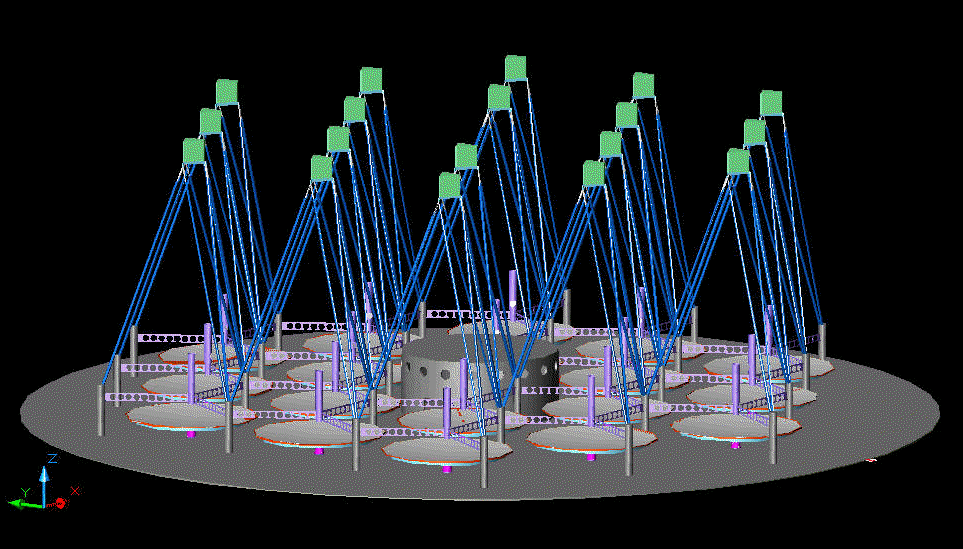 |
| Design |
 |
| Design |

|
|
|
|
|
||
| 1024x768 BMP | 1024x768 BMP | 1024x768 BMP | 1024x768 BMP |
Overview
The baseline LAMA design is an array of eighteen 10-metre diameter telescopes. The light from these telescopes is brought to a common focus. The individual beams can be combined either coherently to produce a high-resolution interferometric image, or incoherently to produce a wider-field image. Each telescope is equipped with a rotating primary mirror, coated with a thin layer of liquid mercury, and an optical tracking system which relays light to the central beam combining room. The tracking system employs moving aspheric mirrors that enable the telescopes to point as far as 4 degrees away from the zenith and to track objects for as long as 30 minutes. An adaptive optics system, provided for each telescope, removes phase distortion caused by atmospheric turbulence. The beam of light from each telescope travels through tubes to the central room. An optical delay line, employing motor and piezo-driven mirrors and a phase-tracking system, provides optical path length compensation for the interferometric mode.
Optical Design
Technically, the array forms a Fizeau interferometer. The entrance pupil, formed by the primary mirrors, intercepts 62% of the light within a circle of diameter 54m. The exit pupil of the system, formed in the beam-combiner, has the same geometry. This enables the telescope to produce diffraction-limited images over a relatively wide field of view.
The individual elements of the array are 10-m liquid-mirror telescopes, shown above. The design of these telescopes is similar to that of the LZT. Each employs a 10-m f/2.5 parabolic liquid mirror, rotating about a vertical axis. Light from the mirror is directed to a system of tracking optics, located near the prime focus, which in turn directs a collimated beam to the central beam combiner.
![]()
The tracking optics, for an individual array element, are illustrated above. The system receives light from the primary mirror and produces a collimated horizontal beam. It contains an aspheric mirror, located conjugate to the primary mirror, which effectively converts the parabolic liquid mirror to a sphere. As the Earth rotates, the entire system moves to follow the image, while the aspheric mirror moves sideways to maintain its alignment with the image of the primary mirror. The small flat mirror rotates to keep the parallel beam horizontal. This system produces distortion-free diffraction-limited images over a 1 arcmin instantaneous field of view, while pointing and tracking as far as 4 degrees from the zenith (Hickson 2002, MNRAS, 330, 540).
Instruments
Our current plan includes two major instruments, an imaging camera and a high-resolution spectrograph.
The
imaging camera would be capable of simultaneous optical/infrared imaging in 6 broad bands with Nyquist sampled images. This camera will use dichroic filters to separate the bands and direct the light to 3 optical CCD arrays and 3 infrared array detectors. Two image scales will provide optimal sampling for all bands whether the telescope is operated in coherent (high-resolution) or incoherent (wide-field) mode. This camera will provide high-quality photometric redshifts for high-redshift galaxies, and enable the detection and study of the first luminous objects in the Universe.The high-resolution spectrograph will consist of 18 separate cross-dispersed echelle spectrographs, each receiving the light from one of the 10-meter apertures that comprise the LAMA array. With a resolving power of at least 100,000, this instrument will enable high-resolution quasar absorption line science programs, studies of exosolar planets and many other programs.
Links